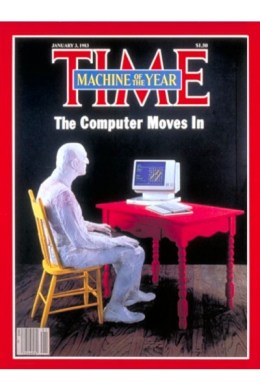
The Machine of the Year cover, with a plaster person by sculptor George Segal contemplating a concept computer which TIME commissioned from a design firm
I don’t have explicit memories of reading TIME’s Jan. 3, 1983 issue back when it was published at the end of 1982. But I’m pretty sure I did, and I certainly took note of it. The franchise which was then known as Man of the Year was a big deal in our family — especially with my grandmother, who would obsessively spend holiday dinners wondering who TIME would pick.
At the time, I was a college freshman and computer nerd. And that 1983 issue was the one in which the magazine made one of its most famous picks, by naming the Personal Computer as its first Machine of the Year.
Recently, I read the entire issue. So can you: We’ve commemorated the Machine of the Year’s 30th anniversary, as well as the 30th anniversary of Apple‘s Lisa computer, by republished the issue as a downloadable bonus in our iPad, Android, Kindle and Nook tablet apps. It includes a new introduction (by me) and is free for subscribers, or $2.99 as a one-time purchase. Subscribers can also read the text of the issue online, but trust me: It’s a lot more fun with the original layouts, photos and ads.
When TIME put together the issue, the PC revolution was still young. (The vast majority of homes didn’t yet have one.) But it wasn’t that young: The MITS Altair 8800, the first PC that mattered, came out in 1975. In 1977, it was followed by the Apple II, Commodore’s PET 2001 and Radio Shack’s TRS-80, the first truly consumery, ready-to-use machines. And another half-decade of evolution occurred before TIME commemorated the PC’s arrival so memorably.
In retrospect, what the 21-page Machine of the Year cover package captures isn’t the beginning of the PC so much as the end of the beginning. The industry still had room for a bevy of hobbyist-oriented, sometimes downright rudimentary computers from Apple, Atari, Commodore, Osborne, Radio Shack, Texas Instruments, Timex (!) and others. None of them had futuristic features like a graphical user interface and a mouse; most ran their own operating systems and weren’t compatible with anything else on the market.
Here and there, though, the issue hints at the changes which would really get underway in 1983. It mentions the IBM PC, which had shipped in 1981, and says that it’s setting standards for the whole industry. But it doesn’t talk about the phenomenon which would dominate the business by the middle of the decade: IBM PC-compatible “clones” which could run the same software as Big Blue’s system. That’s because there was only one clone in existence. (The second, Compaq’s massively successful, sewing machine-sized “portable,” showed up in March 1983.)
The issue does make fleeting reference to two upcoming Apple computers. The first, the Lisa, was formally introduced shortly after the issue appeared. The second was the Macintosh — although the issue calls it both the Apple V and the “Mackintosh” — and it showed up a year after that. They were the first two computers to commercialize the point-and-click interface which originated in the Alto system which Xerox designed in its PARC lab but never put on sale.
The Lisa was an important product which failed, in part because it cost $10,000; the Mac became the PC industry’s longest-running, most influential line of computers. Conceptually, every modern PC — including those that run Windows and Linux — descends from it.
As I wrote in my introduction for the tablet reissue, much has changed about computers since 1983. But one of the striking things about the issue is that it’s jam-packed with reminders of what hasn’t changed. Most of the things we do with PCs, tablets and phones in 2013 are in there: e-mail, games, word processing, learning, personal finance, music and cloud services. (O.K., in the 1980s, they weren’t called cloud services — they were known as “mainframes.”)
1983 and 2013 are similar in other ways, too — ones which make them two of the most exciting periods in tech history. The sheer variety of viable platforms today, from Windows PCs to iOS tablets to Linux phones, reminds me of the early, unstandardized days of the PC. And just as TIME couldn’t have predicted what the PC would look like in 1988, we live in wonderfully unpredictable times today. I cheerfully admit that I have very little idea where we’ll be in 2018.
The PC remains TIME’s first and only Machine of the Year — the only man-made object to be named the year’s top newsmaker. It wouldn’t stun me if it retains that distinction forever. I like to think, though, that there’s at least some chance that we’ll revive the idea someday — maybe for some device which doesn’t even exist today. But it would have to be an awfully important gadget to matter as much as the PC mattered 30 years ago.


